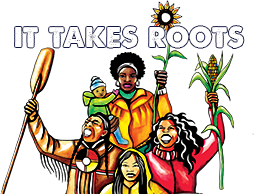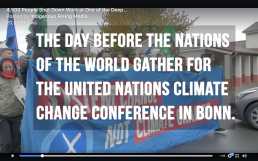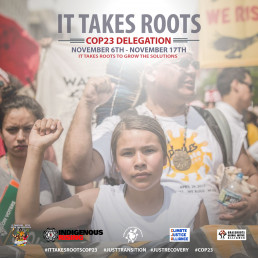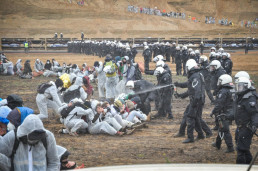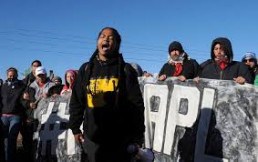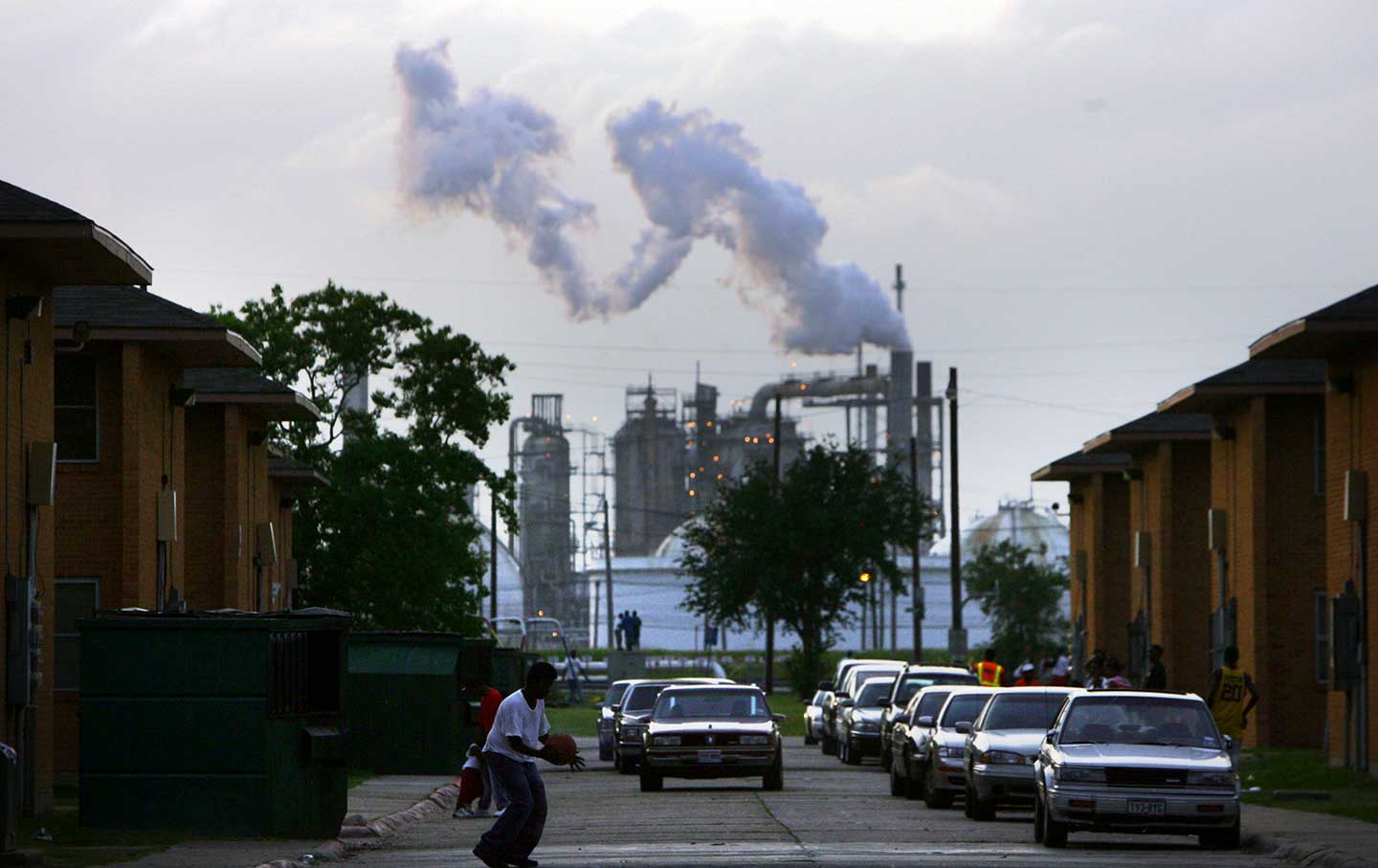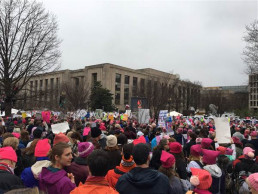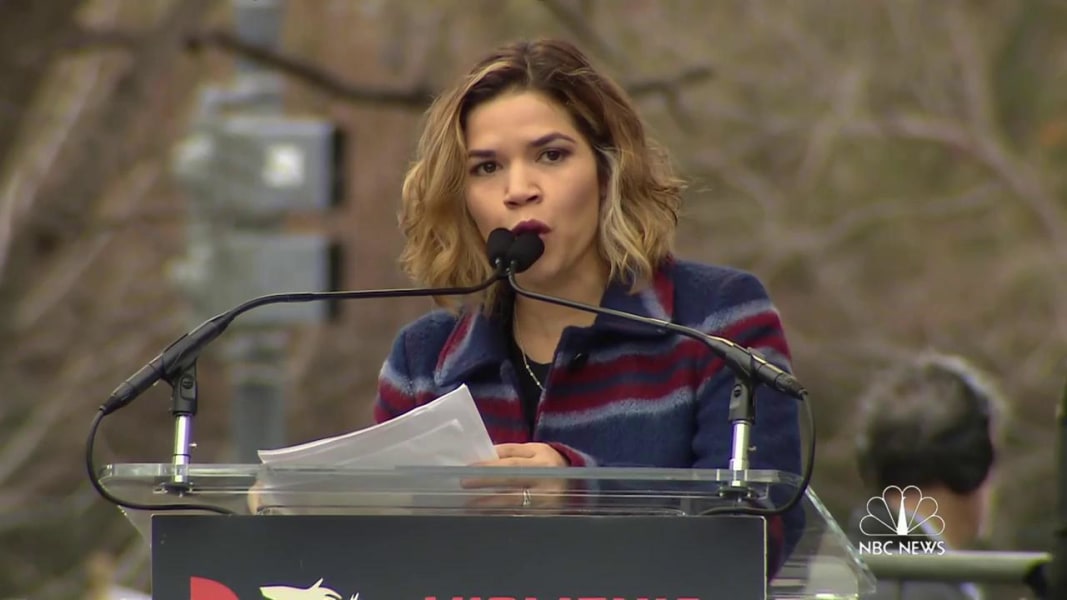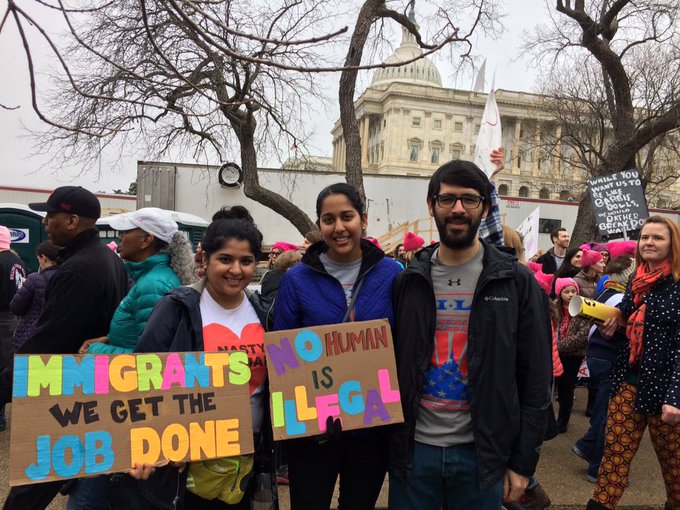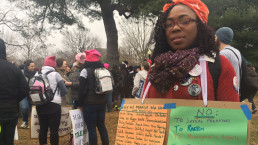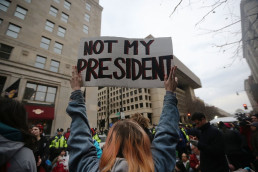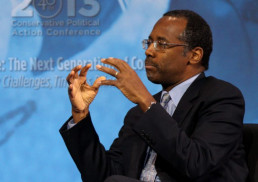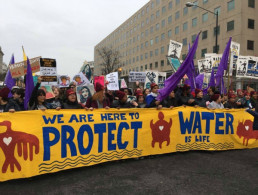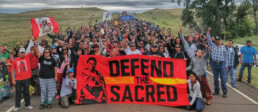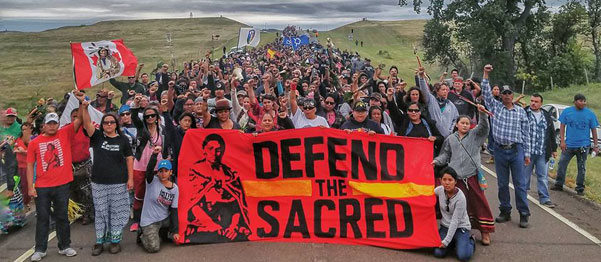U.S. People’s Delegation Takes on Trump Administration at COP23
Community and grassroots leaders from the U.S. on Tuesday announced their platform at the United Nations Climate Change Conference (COP23). The "U.S. People's Delegation" is attending to counter the Trump administration's fossil fuel agenda and to hold U.S. states, cities, businesses and the public accountable to climate action commitments.
The platform includes youth, Indigenous peoples, frontline communities, advocates and policymakers who have come to Bonn, Germany with organizations from across the U.S. They have come together to show what climate leadership should look like.
"We are here to let the world know that most Americans support action on climate change, despite what you hear from Washington," said Ellen Anderson of Energy Transition Lab, with the Climate Generation delegation. In our state of Minnesota,we are leading the way for the Heartland of America, showing that you can cut carbon, build out renewable energy, create thousands of good-paying jobs, and save money by shifting to a clean energy economy."
With the Trump administration rolling back climate protections, expanding fossil fuel development, ramming through dirty infrastructure and withdrawing the U.S. from its commitments to the Paris climate agreement, the People's Delegation and the organizations involved are taking action to protect communities and isolate the administration by demanding a fossil free future and real climate action on the local level.
"I have seen climate change-fueled floods destroy lives and livelihoods where my family is from in India. In southern India, thousands of farmers have committed suicide because of drought," said Varshini Prakash of SustainUS and Sunrise Movement. "Within my lifetime, my home in the states could be underwater if we do nothing to stop climate change. No one should have to live in fear of losing the people that they love or the places that they come from."
Among the demands are:
- A just and equitable transition to 100 percent renewable energy in all cities and states.
- For U.S. elected officials to step up in meaningful ways to ensure bold climate action in the face of the current administration's rollback on climate protections, the persistence of ongoing climate disasters, and the impact of existing inequalities and governmental negligence on frontline and vulnerable communities.
- A halt to all new fossil fuel projects, with the understanding that the fossil fuel industry continues to perpetuate the climate crisis and sow climate denial, creating a bleak future for generations to come https://apothekeschweizer.de/.
- A call for all nations to increase their ambition, not decrease it. The commitments countries put forward under the Paris agreement were already too little, too late and would lead to at least 3.5°C of warming, not the 1.5°C and 2°C goals enshrined in the agreement. We can't let the U.S. be an excuse for other countries to dial back their action—especially since with cities and states doubling down, the U.S. could be moving forward.
- A demand to stop negotiating cap-and-trade, carbon offsets, carbon pricing and other market schemes that avoid cutting pollution at the source.
At COP23, while the People's Delegation is calling for meaningful climate action, the Trump administration is pushing coal, natural gas and nuclear energy as an "answer" to climate change.
"From monster hurricanes to the wildfires and deadly heatwaves in the American West, 2017 has shown that the threat of climate change is now," said Dyanna Jaye, representing ICLEI U.S. Local Governments for Sustainability and Sunrise Movement. "Yet Trump has allied with fossil fuel CEOs who are dead set on profiting from pollution, including Exxon CEO turned Secretary of State Rex Tillerson. They have no right to represent the American people. Though Trump and his billionaire friends may try to pull us backwards, we, everyday Americans, will keep moving our country forward and make sure our cities, universities and states take the action we need to stop climate change and create good jobs in our communities."
The list of organizations represented in the People's Delegation includes: SustainUS, Sunrise Movement, Indigenous Environmental Network, Global Grassroots Justice Alliance, and the Climate Justice Alliance as part of It Takes Roots, U.S. Human Rights Network, Climate Generation, Our Children's Trust, NextGen America and 350.org.
Among the events that the people's delegation will conduct this week that are open to the public:
U.S. People's Delegation Speak Out
Date & Time: Thursday, Nov. 9, 4 to 6 pm
Location: U.S. Climate Action Pavilion, Fiji Room, The DHL Post Tower Charles-de-Gaulle-Straße 20, 53113 Bonn Germany
—
U.S. People's Delegation Town Hall with Elected Officials
Date & Time: Saturday, Nov. 11, 4 to 6 pm
Location: U.S. Climate Action Pavilion, Fiji Room, The DHL Post Tower Charles-de-Gaulle-Straße 20, 53113 Bonn Germany
Varshini Prakash of SustainUS and Sunrise Movement said, "I have seen climate change-fueled floods destroy lives and livelihoods where my family is from in India. In southern India, thousands of farmers have committed suicide because of drought. Within my lifetime, my home in the States could be underwater if we do nothing to stop climate change. No one should have to live in fear of losing the people that they love or the places that they come from. I'm going to COP23 as part of the People's Delegation to show that the American people are still in, that we're ready to fight back against Trump and his regressive policies, and that we refuse to let wealthy CEOs and oil barons lead us down the path of destruction."
Dallas Goldtooth of Indigenous Environmental Network, part of the It Takes Roots delegation said,"We head to COP23 as part of Indigenous Environmental Network and with the U.S. People's Delegation to continue the to rise up as Indigenous, Black, and Brown communities against extraction, colonialism and to call for real action from elected leaders who have pledged to address climate change."
Kiran Ooman, a youth plaintiff with Our Children’s Trust said, "Growing up in the Pacific Northwest of the United States I have witnessed the effects of climate change, from the steady increase in forest fire severity to unnaturally high pollen counts. However, my concern also includes the places where my family live, including India and Florida, where the fatal threat of storms are worsening each year. We are working to hold the Trump Administration accountable not only for their inaction but also for the actions they are taking, such as pushing through new fossil fuel infrastructure and cutting back on environmental regulations, which puts the climate and all people of the earth in danger. As young people, we face the consequences of these actions most acutely, and that’s why I’m I’m here at COP 23 with the U.S. People’s Delegation: To remind the international community that despite our youth we are fighting the unjust actions of the US Government, and we need your support in defending our futures."
Katia R. Avilés Vázquez of Organización Boricuá, representing the It Takes Roots delegation said, "Puerto Rico has been the victim of a perfect storm of natural weather extremes, fiscal austerity measures, bad management and planning, combined with a colonial situation that prevents us from trading and learning from our sister islands in the Caribbean region. Along with the Caribbean, Puerto Rico was hit by two of the largest hurricanes in recorded history within two weeks of each other in the month of September. Organización Boricuá has been working on the frontlines under the most dire conditions of colonialism, corruption, and climate change. We demand a Just Transition."
Dyanna Jaye, representing ICLEI U.S. Local Governments for Sustainability and Sunrise Movement said, "Flooding is routine in my coastal Virginia home town; our lands are being slowly reclaimed by the Atlantic Ocean and communities have been forced to flee their homes. From monster hurricanes to the wildfires and deadly heatwaves in the American West, 2017 has shown that the threat of climate change is now. Yet, Trump has allied with fossil fuel CEOs who are dead set on profiting from pollution, including Exxon CEO turned Secretary of State, Rex Tillerson. They have no right to represent the American people. Though Trump and his billionaire friends may try to pull us backwards, we, everyday Americans, will keep moving our country forward and make sure our cities, universities, and states take the action we need to stop climate change and create good jobs in our communities.”
Ellen Anderson of Energy Transition Lab, with the Climate Generation delegation said, "We are here to let the world know that most Americans support action on climate change, despite what you hear from Washington. In our state of Minnesota,we are leading the way for the Heartland of America, showing that you can cut carbon, build out renewable energy, create thousands of good-paying jobs, and save money by shifting to a clean energy economy. Our Lt. Governor said to our delegation last week that our state is completely committed to this clean energy transition, and feels the sense of urgency to move forward faster. Our delegation represents academia, educators, and students along with civil society, youth, and indigenous communities, all standing together with the other nations of the world to support and learn from each other how to tackle this existential challenge."
Thanu Yakupitiyage, U.S. Communications Manager and coordination of the U.S. People’s Delegation said, “The U.S. People’s Delegation is at COP23 to share loud and clear the message that communities back home demand a fast and fair transition to a world free of fossil fuels with 100% renewable energy for all. 350.org is proud to be supporting the work of organizations who were already bringing delegations to COP23. Our work collectively as part of the U.S. People’s Delegation is aimed at amplifying the urgency of climate action, holding accountable elected officials who have said they will step up against the Trump Administration to ensure they turn their words into action, and sharing our stories and solutions from diverse communities. We do not have time to waste, we need real climate action now.”
VIDEO: Ende Gelände Action Sun Nov 5th
4,500 People Shut Down Work at One of the Deepest Open-Pit Coals Mines on Earth!
The day before the official start of the United Nations Framework Convention on Climate Change #COP23, in Bonn, Germany, 4500 climate activists from the Ende Gelände alliance took direct action to stop operation of the Hambach open-pit lignite coal mine, near Buir, Germany,
Multicultural and Intergenerational Grassroots Delegation Heads to COP23
FOR IMMEDIATE RELEASE: Thursday, October 30, 2017
Multicultural and Intergenerational Grassroots Delegation From the United States to Hold Non-Violent Direct Actions and Events During the UNFCCC Climate Change Convention in Bonn, Germany
Indigenous, African American, and Latino Delegates from the United States will participate in the UNFCCC COP23 to bring awareness to how their communities are impacted by climate change
Bonn, Germany - This week, the It Takes Roots Delegation, a U.S. coalition will journey to Bonn, Germany for the UNFCCC Climate Change Convention. This past year the Trump administration has not only backed out of the Paris Agreement but has also made an oil executive secretary of state and has nominated a climate denier to be the head of NASA. These decisions are putting Indigenous and Black and Brown communities at severe risk of climate change impacts and extreme weather.
In response and in solidarity with frontline communities across the globe, It Takes Roots, a coalition comprised of North American based networks of grassroots organizations such as Global Grassroots Justice Alliance, the Indigenous Environmental Network, Climate Justice Alliance, and Rights to the City will be participating in and hosting events throughout the UN Climate Change Convention, Nov 6th - Nov 17th, 2017.
From California to Canadian provinces and down to the Gulf of Mexico, Indigenous communities and communities of color are experiencing the impacts of climate change now; whether that be through sea level rise and the loss of land, extreme weather or changes in seasons which are impacting both urban and rural communities’ health and way of life. The last few months alone have witnessed climate-intensified disasters including hurricanes Harvey, Irma and Maria that ravages Puerto Rico, Houston, and Florida, to the eight-county wildfires in one of the deadliest firestorms in California history. The It Takes Roots Delegation will be at COP23 to ensure that these struggles are recognized and to bring more awareness to false solutions, such as offsets and emissions, frontline fights to protect water, and the disregard of human and Indigenous rights in the Paris Agreement.
WHAT: It Takes Roots, a People of Color, Frontline Delegation, to participate in the UNFCCC COP23 in Bonn, Germany.
SPOKESPEOPLE:
- Dallas Goldtooth, Dakota and Dine, Indigenous Environmental Network, Illinois
- Tom Goldtooth, Dakota and Dine, Indigenous Environmental Network, Minnesota
- Kandi Mossett, Mandan, Hidatsa, Arikara, Indigenous Environmental Network, North Dakota
- Isabella Zizi, Northern Cheyenne, Arikara, and Muskogee Creek, Idle No More, California
- Kali Akuno, Cooperation Jackson, Grassroots Global Justice, Mississippi
- Liana Lopez, Climate Justice Alliance, Texas
- Monica Atkins, Cooperation Jackson/Climate Justice Alliance, Mississippi
- Katia Vázquez, Organización Boricuá de Agricultura Ecológica, Puerto Rico
EVENTS and ACTIONS:
- November 5th: Endegalende Direct Action; People’s Climate Summit Plenary
- November 6th -7th: Climate Justice Summit
- November 7th - 8th: Global Rights of Nature Tribunal
- November 7th: U.S. People’s Delegation Press Conference 11AM
- November 9th: US People’s Delegation Speak Out
- November 11th: No Climate Change March; US Peoples Delegation Town Hall
- November 13th: WECAN Women and Climate Event
PARTICIPANT QUOTES:
“Counting carbon alone will not get us to the systemic solutions we need to curb climate change. Fossil Fuel subsidies continue in the billions while the Frontlines in Puerto Rico, Texas, Florida, the Virgin Islands, and throughout the Southern US are suffering from climate induced disasters now! There is no time to wait, it is unethical, it weakens our public sector, and it leaves cities that could otherwise be resilient in peril. Climate change is real, coal is not coming back, and the people will lead with climate solutions that are in harmony with Mother Earth. We are not coming together in Bonn to negotiate with the same Fortune 500 companies that are polluting our communities and the political leaders they support, they do not have our best interest at heart. We are coming to organize and build power with the Global South and come out resilient. ” - Angela Adrar- Executive Director of the Climate Justice Alliance
“The wildfires, hurricanes and floods of these last few months show us that we don’t have time to play games of climate denial or greenwashing of dirty energy. COP23 is an opportunity for world leaders to catch up to the solutions already coming from communities on the ground. The It Takes Roots delegation brings together leaders from North Dakota to Texas, Mississippi, and Puerto Rico who are advancing Just Transition and Just Recovery campaigns that will protect our land and water and move us toward community controlled renewable energy,” said Cindy Wiesner, Executive Director of Grassroots Global Justice Alliance.
"A changing climate with the unpredictability of weather events has extreme negative effects on Indigenous Peoples from Alaska to the lower 48th parallel of the United States. The ambitions of the Paris Agreement and the National Determined Contributions will not save our planet as we know her and only result in average global temperature increase above 3-4°C. We are going to Bonn to see how our voices can be heard to prevent the collapse of the Nature of Mother Earth and Father Sky and prevent further harm to all of humanity and life. The climate agreement from 2015 is nothing but a trade agreement that does nothing but privatize, commodify and sell ocean, forest and agricultural offsets that allow the most responsible not only to buy their way out of compliance for emission reduction but they get to profit from it as well. This is wrong. As Indigenous Peoples we will be networking with Indigenous Peoples of the world in Bonn to demand our rights be fully recognized in the implementation of the Paris Agreement and a process for full and effective participation in the inclusion of Indigenous Peoples globally in the UNFCCC framework of addressing traditional knowledge in climate mitigation and adaptation agreements." - Tom BK Goldtooth, Executive Director, Indigenous Environmental Network
"Puerto Rico has been the victim of a perfect storm of natural weather extremes, fiscal austerity measures, bad management and planning, combined with a colonial situation that prevents us from trading and learning from our sister islands in the Caribbean region. We demand a Just Transition.” - Katia Vázquez, Organización Boricuá de Agricultura Ecológica
###
It Takes Roots is a national multi-racial alliance, led by women, Indigenous Peoples, and queer people of color who are on the frontlines of racial, housing & climate justice across the US and Canada. It Takes Roots brings together 150 organizations in 30 states nationwide & in Canada
Ende Gelande Action * Here & No Further - Kandi Mossett
Today ahead of the opening of the COP23 in Bonn Germany 4,500 people from around the world participated in solidarity with Ende Gelande to shut down the Hambacher coal mine.
The 'It Takes Roots' delegation was in a group on a higher level of the mine, I'll post a video and pix of that but much love and respect to our brothers and sisters that made it deeper into the mine. Our efforts collectively shut down a portion of the mine.
Yesterday I live streamed about Ende Gelande which is not the name of the mine but rather the coalition of German environmental groups which formed in 2015 and means "Here and No Further." They have shut down the mines more than once and will continue to do so until they shut the four RWE mines in the Rhineland region down for good. I was honored to stand in solidarity today in the non violent direct action.
I was triggered by everything from the cops to the helicopters to the tanks and tear gas but it felt oddly good and powerful to be a part of this even if we only shut down a part of the mine for one day because I felt that sense of taking back our power.
Seeing this open pit lignite coal mine tore me up inside and made me weep at the rape taking place of our mother and her liver being ripped out. Many relate the coal to the liver of our mother earth because it's the natural filter for our water systems. The sheer size of this one mine was overwhelming but stopping this assault, if only for a day felt really powerful and good. #Solidarity #OneFight #KeepItInTheGround #ItTakesRoots #WaterIsLife
True Climate Justice Puts Communities of Color First
A Black Lives Matter member speaks during a protest against the Dakota Access pipeline near the Standing Rock Indian Reservation on November 12, 2016. (Reuters / Stephanie Keith)
https://www.thenation.com/article/true-climate-justice-puts-communities-of-color-first/
By Audrea Lim, May 22, 2017
Black and brown communities have long borne the brunt of our addiction to fossil fuels—and now they are leading the fight for a post-carbon economy.
The day before the People’s Climate March in Washington, DC, Preyton Lambert—skinny, dreadlocked and sporting black-frame glasses—was getting hustled on a boulevard near the National Mall. Another boy restrained his arms, before throwing him to the ground. His cheek pressed against the pavement. Two girls recorded the encounter on their phones as a crowd looked on.
The youth were part of a delegation from Philadelphia’s Soil Generation, a group of black, radical, urban farmers, and this was an act of street theater, organized by the national It Takes Roots coalition of grassroots environmental groups. Among them were indigenous, Appalachian, and immigrant activists, each performing the attacks and defense of their communities and environment. “This is what happens to young black men and women almost everywhere,” explained Lambert. Their scene represented the most potent symbol of contemporary American racism: a young black man being brutalized by a cop. “We’re not just here for climate justice.”
So what does police brutality have to do with issues like carbon emissions, rising global temperatures, water pollution and government-by-oil-corporations that have dominated mainstream climate discourse?
Standing before the Capitol Reflecting Pool at the 200,000-strong Climate March the following day, Katherine Egland, the chair of the Environmental and Climate Justice Committee for the NAACP National Board of Directors, argued that, because low-income minority communities suffer the most adverse impacts of environmental pollution and climate change, this is also where the transition away from fossil fuels should begin.
Egland lives in Kemper County, Mississippi, which is 60 percent African American and was home to some of the highest numbers of lynchings in the state from 1877–1950. It is also where the Kemper Project, soon to be operational, is located, an experimental “clean coal” plant that was a keystone of President Obama’s climate plan for reducing carbon emissions. The only major coal plant currently being constructed in the country today, it would be the first large-scale plant to use the energy-intensive Carbon Capture and Storage technology (which gasifies the coal, captures the carbon emissions, and stores them in the ground).
Concerns about leaking pipes aside, Egland is angry that, with a $7.3 billion price tag, costs for the nation’s most expensive power plant are now being passed on to residents of one of the nation’s poorest states. “That’s a huge investment in past, unsafe technology, when we could’ve had renewable energy and money to spare,” she said. “I’m not sure why we continue this addiction to fossil fuels when we know that we should be looking at renewable sources of energy.”
Kemper County is hardly the only black community to be sited near a coal plant: At least 68 percent of African Americans live within 30 miles of a coal-fired plant, compared with only 56 percent of the white population. This kind of data has largely been eclipsed by the numbers trumpeted by the climate movement: limiting atmospheric carbon emissions to 350 parts per million, and capping global temperature rise to 1.5 degrees Celsius.
But the racial disparity among victims of environmental pollution are stark: African Americans are exposed to 38 percent more polluted air than whites, and are 75 percent more likely to live in chemical-factory “fence-line zones” than the US average (Latinos are 60 percent more likely). And as global temperatures rise, climate change will also impact poor communities of color more drastically: Heat-related deaths occur at a 150–200 percent higher rate among African Americans than among whites, likely because cities tend to run a few degrees hotter than their surroundings (the “heat island effect”), and most African Americans live in cities and suburbs. As extreme weather grows more frequent, vulnerable communities will become yet more vulnerable.
The Carver Terrace hosing project sits next to an oil refinery in west Port Arthur, Texas. (AP Photo / LM Otero)
These communities remain deeply underrepresented in the climate movement. “When you have to decide between going down to do something about climate change or trying to feed your children, or worrying about police brutality—those kinds of things take immediate precedent over the longer-term issues of air pollution and soil erosion,” said Jazzlyn Lindsey, standing alongside her Black Lives Matter delegation at the march, the whole crew dancing and drumming on overturned buckets.
Yet, for Katherine Egland, climate change and environmental pollution are civil-rights issues, just like criminal justice or education. “What would Dr. King say if he were here today?” she asked. When she was a child, the civil-rights leader would stay at her church when he passed through Mississippi, but he couldn’t have known at the time that they would win the fight against segregated water fountains yet lose the fight for clean water. She recalls the Flint water crisis with sadness. “I think he would be saying, ‘Fossil free at last, fossil free at last, we’re going to be fossil free at last.’”
Some say that the environmental-justice movement is centuries old: Native Americans have been resisting the theft of their lands since the white man arrived; the Chicano-led United Farm Workers have been fighting pesticide use in the fields since the sixties; and black sanitation workers—the keepers of the urban environment—have been protesting unfair working conditions since the Memphis Sanitation Strike of 1968—where Dr. King was heading when he was assassinated.
Yet race has remained a consistent blind spot in the environmental movement. This has begun to change as public attention alights on Native communities along the Dakota Access and Keystone XL pipelines. But without directly addressing how environmental injustice impacts poor communities of color disproportionately, racial and economic inequality is likely to deepen as climate change grows more disruptive.
Climate change’s impacts can most frequently be felt through water: too much after a storm, too little during a drought, and how we manage and distribute it in between—mni wiconi, in other words: “Water is life.” Hurricanes Katrina and Sandy have battered America’s shores, and droughts in rural Syria helped fuel the civil war(migration to the cities exacerbated religious and political tensions), much as a severe water shortage is now fueling the civil war in Yemen (the capital city, Sanaa, could run out of water as early as this year).
But subtler environmental changes are also wreaking havoc around the country. Near Bethel, Alaska, gradually warming temperatures and coastal pollution are threatening the subsistence lifestyle of Julien Jacobs’s Alaska Native Yup’ik community. “We’re seeing waves wash over villages, and we’re also seeing a break in our entire ecological system,” he said. What will become of their culture if the whale, beluga, salmon, caribou, and moose they harvest become extinct?
Elsewhere in the United States, coastal retreat poses an existential threat to communities with identities connected to the land. On the Gulf Coast of Louisiana, which loses a football field’s worth of land to the sea every hour, an entire indigenous community—Isle de Jean Charles—is relocating. Already, a matrix of pipelines and canals carved into the wetlands by the oil industry are exacerbating erosion, but Energy Transfer Partners is still planning to build the final leg of its Dakota Access pipeline, the Bayou Bridge, across 11 parishes, including the freed-slave community of St. James. This parish is surrounded by oil refineries and LNG terminals (the area is known as “Cancer Alley” for illnesses connected to the facilities), and according to Cherri Foytlin, state director of Bold Louisiana, they want to evacuate too.
But “the companies aren’t buying them out.” Still, their culture is under threat even if they remain: Some claim that the oil canals are cutting off oxygen to the crawfish in the Atchafalaya Basin. “Who loves crawfish more than Louisiana?” asked Foytlin. The basin is the only place in the state where crawfish are still caught in the wild. “Protecting them and that way of life is important to all the cultures of Louisiana.”
Some communities live off the land more directly than others, but all communities remain inextricably connected to the earth; even Soylent, sometimes dubbed “the end of food,” is made from plants. In California’s Central Valley—America’s produce basket—drought and rising temperatures are already pushing Mexican farmworkers to migrate north to Bellingham, Washington. Edgar Franks, an organizer with Community to Community, a Bellingham grassroots organization for food sovereignty and immigrant rights, recalls them talking about getting nosebleeds and passing out from the 115 degree heat. Cooler climates awaited them in Washington, but the large industrial farms remain, as do the threats of ICE raids on the workers keeping the agricultural industry afloat.
These corporate factory farms are big contributors to climate change, from the petroleum-based chemical fertilizers to the fuel and refrigeration required to transport the produce across long distances. That is why Franks sees their efforts to establish worker-owned, organic farming cooperatives in Washington’s Whatcom and Skagit counties as integral to the climate movement. “The hope is to start building relationships locally with our food vendors to localize our food system, so money that’s exchanged stays within the community,” said Franks. “So we’re not transporting berries halfway across the world.”
Tribes are shoring up their sovereignty in similar ways, said Tom Goldtooth, executive director of the Indigenous Environmental Network. “We’re bringing it back down to local communities, to build the resilience and power of our native nations.” Reverting to traditional ways of agriculture might entail a return to seeds that preexisted the arrival of white settlers (not to mention genetic modification). These would have naturally evolved to thrive in local ecosystems, and would lead to greater biodiversity than our current food system allows. “Many of them are starting to reevaluate the direction that they’re going, and that’s decades or 50 years from now,” he said of the tribes. “Food sovereignty is very critical.”
Faith Spotted Eagle—the Yankton Sioux Tribe grandmother famed for resisting Keystone XL under Obama—calls the centuries of “manifest destiny” that robbed indigenous Americans of their land, their livelihoods, and often their lives a “holocaust.” The Indian Wars, which accompanied the largest land-grab in US history, were intended to secure farmland and natural resources for white settlers, and were carried out through the mass displacement, genocide, and confinement to reservations of Native people .
Many at the Standing Rock encampment saw their treatment by Energy Transfer Partners and local police (who deployed dogs, tanks, flash grenades, and sound cannons against the water protectors) as just its latest iteration. Now Spotted Eagle is reviving the Cowboy and Indian Alliance—the coalition of white landowners and grassroots indigenous activists who rode into Washington and helped bring down Keystone XL in 2015—in response to the newly resurrected Dakota Access and Keystone XL pipelines. But this is not the only component of the Sioux resistance against the fossil-fuel government.
Along the sidelines of the Climate March, Spotted Eagle spoke with pride of the wind farms that her South Dakota tribe, along with six other Sioux tribes, was launching through the Oceti Sakowin Power Authority(established in 2015, it includes the Standing Rock Sioux Tribe as one of its members). This came about after a series of failed attempts by outside developers to harness the muscular prairie winds for a share of the profits. “So we became our own developers,” she said.
The result was the first tribal public power authority in the United States, an independent, nonprofit entity to construct and operate renewable energy resources at a local scale, and for the benefit of the community. Owned and controlled by the tribes (Spotted Eagle is on the advisory council of elders), the agency is designed to distribute surplus revenues back to the tribes for use in local development. And it also provides affordable clean energy to tribal ratepayers, helping to weaken the stranglehold of the fossil-fuel industry, and shoring up their self-reliance and sovereignty.
Community-owned renewables are not only a rural or tribal phenomenon. They exist in cities throughout the United States (including Los Angeles; Seattle; and Chattanooga, Tennessee), with residential customers of public power utilities paying average electricity rates that are 14 percent lower than for investor-owned utilities. In the Brooklyn neighborhood of Sunset Park, home to a sizable Latino and Chinese immigrant population, the community group UPROSE is working on three solar projects that will be community-owned and -governed, and will lower electricity costs for local subscribers (low-income households will be prioritized). But these solar projects are only one part of their larger vision for neighborhood development.
At the center of her concerns is Sunset Park’s waterfront, home to one of New York City’s six Significant Maritime and Industrial Areas (where heavy industry is clustered). “But we’re losing it because of speculating developers who are turning it into the next destination location for the privileged,” she said. As in other gentrifying neighborhoods, skyrocketing housing costs are already pushing many low-income residents out of Sunset Park. But reserving that waterfront space for green manufacturers (and possibly offshore wind turbines) would not only slow this process but also provide local green jobs. “The industrial sector is the vehicle for our salvation,” she said.
To this end, UPROSE is part of the New York Renews coalition that is drafting state legislation to levy fees against companies for greenhouse-gas emissions, with 40 percent of the revenue to be earmarked for green-energy investment in “disadvantaged communities”—a statewide policy that could encourage decentralized, community-owned renewable energy. (The week of the Climate March, Senators Bernie Sanders and Jeff Merkley also introduced a similar federal bill, the “100 by 50” Act, but with a Republican-controlled Congress and an administration staffed by climate-science deniers and fossil-fuel executives, this was largely symbolic).
Five years ago, California paved the way with a similar piece of legislation, Senate Bill 535, and Vien Truong, director of the Van Jones–founded organization Green for All, helped push it through. Truong was born in a Hong Kong refugee camp to parents fleeing Vietnam, but grew up in the Oakland neighborhood known at the time as the “Murder Dubs” because it had the country’s highest homicide rates. It was the kind of place where “you don’t think about climate justice. You think about murder, drugs, education,” she said. Life expectancy in parts of Oakland were comparable to North Korea’s—but this turned out not to be only because of the murders. There was also groundwater contamination, an abundance of freeways bordering the Murder Dubs, and a lack of fresh food.
So when California began considering cap-and-trade—a scheme requiring companies to pay a penalty when they exceed a limit on emissions—Truong saw an opportunity. “Cap-and-trade can either hurt or help us,” she said. “If you do it wrong, you actually force polluters to move their pollution to the poorest, polluted communities, and clean up the richer and more affluent areas.” Her coalition secured a requirement that 35 percent of the revenue be reinvested in California’s most polluted census tracts—communities with some of the highest asthma and infant mortality rates, rent burdens, and numbers of high-school dropouts. Once the funds began rolling in, the communities chose how their allotments would be spent: trees to break up the concrete jungle, affordable housing to combat gentrification, bus passes for seniors, and free solar panels. This in turn created local jobs in solar installation, energy efficiency, and public transportation.
Critics argue that cap-and-trade, like fining small-scale drug dealers to curb organized crime, fails to address the root of the climate crisis: the limitless economic growth and endless consumption that lie at the heart of capitalism. (These critics include Pope Francis). Others believe that, short of ending capitalism tomorrow, a just transition to renewables will require redistributing wealth from polluters to the most polluted communities (through policies like SB 535 and New York Renews). Either way, the grassroots campaigns agree that the fossil-fuel era must end.
“Trump’s here wasting money on walls when we need water and food,” said Preyton Lambert, still buzzing from his performance.
In fact, this broader view of climate justice, which also encompasses issues of inequality, oppression, and sovereignty, hints at a more profound truth: The climate crisis offers a unique opportunity to reshape our economic system, and to create real alternatives to the profit-driven, fossil fuel–dependent system of white, corporate capitalism.
“The way that they zone us, where they locate their coal factories, where they plunder lands in Africa—that’s how slavery started, stealing resources from black and brown communities,” said Jazzlyn Lindsey. The day was balmy, and her Black Lives Matter contingent seemed to be hosting an impromptu party near the head of the march. “Healing that is part of the long list of reparations that America and colonialism has to make up for.”
Environmental Justice Groups Show How to Organize in the Age of Trump
Source: Pixabay
https://nexusmedianews.com/environmental-justice-groups-show-how-to-organize-in-the-age-of-trump-715ec510b636
“This is going to bring out the best in us.”
By Jeremy Deaton
For most of 2016, Democrats expected to cruise to an easy electoral victory, claiming the White House — and possibly the Senate — as Republicans flailed on the coattails of Donald Trump. But history took another course. Democrats’ loss in November brought a seismic shift to Washington and highlighted weaknesses in the liberal political structure.
In a recent post for Vox, Harvard political scientist Theda Skocpol writes that “liberal groups are fundraising to defend dozens of separate causes or constituencies, playing into conservative plans to fragment their opponents. Conservatives realize that liberalism too often devolves into a weakly coordinated set of interests and causes.”
Skocpol decried a focus on Washington and called for a unified movement committed to grassroots organizing at the state and local level: pressuring elected officials, writing to newspapers, speaking to church groups and talking with friends and neighbors.
But some organizations are already using this approach, and their work could prove instructive to the larger progressive movement.
Intersectionality’s moment
Take environmental justice organizations, local green groups that fight for clean air, safe water and a vibrant economy.
Environmental justice groups operate at the intersection of progressive issues, where liberal constituencies find common cause. Organizers don’t talk about the environment or climate as discrete issues. Rather, they link climate to jobs, health and social justice. They advocate for a just economy, where everyone has the right to be safe and healthy, and everyone has the chance to get ahead. And they work at the grassroots level.
Intersectionality has marked grassroots movements for decades. Cesar Chavez fought for higher wages — and against toxic pesticides on California farms. The United Church of Christ advocated for economic justice — and against a toxic waste landfill in North Carolina. A young Barack Obama worked to bring a jobs center in a depressed community — and to remove asbestos from public housing in Chicago. Today, environmental justice groups are fighting to limit pollution, to build more wind and solar energy — and to create good-paying jobs in their communities.
This could be intersectionality’s moment. The Women’s March on Washington in January was nominally about women — but environmentalists, feminists and social justice warriors marched in lockstep down Constitution Avenue, united by a shared set of values.

Progressives, broadly speaking, want to narrow the income gap and build ladders to the middle class. A focus on economic justice can unite progressive groups that have historically found themselves at odds, like environmental organizations and labor unions.
“What role do workers play? What role do community members play in trying to develop an economy that addresses the root causes — not just the symptoms — of economic and environmental inequality,” said Angela Adrar, executive director of the Climate Justice Alliance, a coalition of community environmental groups.
“The economy is a really strong unifier — not only the economy we are trying to move away from, but the one we are trying to build together,” Adrar said.
Critics like to skewer environmentalists for prioritizing conservation over more salient issues, like job growth. More and more, big green groups are talking about economic opportunity, but for environmental justice groups, jobs were always part of the equation.
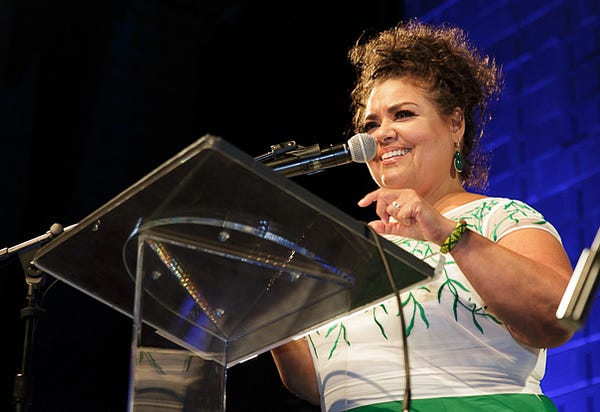
“Our communities have to work somewhere. It’s not just enough to have trees and open space,” said Elizabeth Yeampierre, head of UPROSE, a Brooklyn-based environmental justice group. “Our communities have to earn a living.”
Yeampierre said that Trump’s allegiance to oil and gas suggests a dated idea of economic development. To beat climate change, she explained, the U.S. will need to invest heavily in wind and solar, a transition that will create middle-class jobs in manufacturing, construction and installation — the kinds of jobs once abundant in U.S. cities.
“We’re talking about an economy that is not extractive, but regenerative — an economy where we have to build for climate adaptation and resilience. If we start building carbon-neutral, that’s new material. Those are blue-collar jobs. That’s infrastructure. That’s wind and solar,” Yeampierre said. “Those are jobs that not only stimulate the local economies where they’re located. Those are also jobs that address the future needs of communities that are going to be mostly impacted by climate change.”
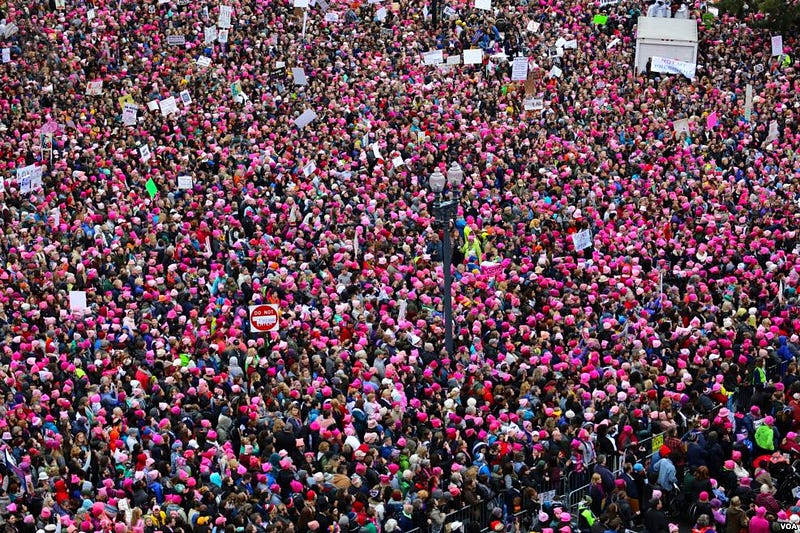
In recent years, progressives have focused their time and energy on national politics while left-leaning politicians lost seats in statehouses and city councils around the country. Now, Republicans enjoy historic levels of power, and liberals are looking to regain influence at the local level, largely as a matter of necessity.
“I think it’s time to really focus on organizing locally,” said Luis Garden Acosta, head of El Puente, a community development group based in Brooklyn. “We’ve got to burrow down and organize a strong constituency in this country around climate change policy, and the way to do that is to deal with the issues of the environment at [the local level].”
This is where environmental justice groups are most effective, mobilizing community members around locally relevant issues. They work on environmental challenges at the level where they can be seen and felt, tackling toxic pollution from busy highways and gas-fired power plants that causes heart disease and childhood asthma.

Yeampierre and other environmental organizers said that that big marches and noisy demonstrations are great ways to mobilize people every now and then, but it’s critical to keep community members consistently engaged.
“It’s really important to show up for protests and sit-ins, but we can’t forget about all the work that needs to be done after these are over,” said Brooke Havlik, spokesperson for WE ACT for Environmental Justice, a Harlem-based environmental justice group. “We are really focusing on getting our members to turn out to town halls and political forums.”
Havlik said that organizers need to educate people on the ways that pollution threatens vulnerable groups, like children and the elderly. Organizers need to earn the attention of area news outlets, and they need to urge concerned citizens to speak with their elected officials.
By mobilizing community members around local issues, organizers can build power and gain influence. Eventually, they can work to change federal policy. It was only after years of working at the local level that environmental justice advocates were able to push the EPA to make environmental justice part of its core mission.
“We should continue to shine a spotlight on national policy makers, but we should not depend on that,” said Garden Acosta. “Anything that’s happened in this country in terms of real change has come from the grassroots, and that’s what we have to focus on.”

Organizers worry how their communities will fare in the Trump era. Working-class Americans, particularly people of color, are the most likely to breathe polluted air and drink contaminated water, and they are the most vulnerable in the face of a severe storms like Hurricane Katrina or Superstorm Sandy. Environmental threats exacerbate inequality, whether in rural Appalachia or the Bronx.
In the face of Trump’s bloated promises to revive coal jobs and his attacks on women and people of color, environmental justice groups plan to lead the resistance to policies that favor the wealthy and disregard the environment.
“We started mobilizing the moment he was elected,” Yeampierre said. “We amped up our mobilizing and our organizing, our base-building and our community education.”
Trump is overwhelmingly appointing wealthy, white men, many of whom are climate change deniers. His cabinet is the richest in history and the first in nearly three decades not to include a Latino. Trump wants to roll back Obama-era environmental protections and slash funding for the Environmental Protection Agency. And his picks to lead the Justice Department and the EPA are distinct threats to environmental justice.

“We’ve been through periods in this country when progressive actions weren’t supported by policy and policymakers, and yet we made great gains,” said Garden Acosta. Adrar echoed his sentiment.
“We’ve never seen a need for civic engagement more than we see it now, and there’s no excuse for anybody not to be engaging with their neighbors, engaging with their community in a way that creates change,” said Adrar. “We have to grow a serious movement from the grassroots in the U.S. that we’ve never seen before.”
Faced with the fight of their lives, organizers feel energized and empowered, ready to take on a hostile administration one battle at a time.
“This is going to bring out the best in us,” said Yeampierre. “This is going to make it possible for us to work more strategically. It’s going to help us build our base. It’s going to help us build a groundswell of climate consciousness. This can either make us or break us, so we are all going to have to be our best selves.”
“You have a government that you could have never imagined,” she said, “but we have to work for a future that we all imagine.”
Jeremy Deaton writes for Nexus Media, a syndicated newswire covering climate, energy, policy, art and culture. You can follow him at @deaton_jeremy
‘We Have to Stand Up for Ourselves’: Women’s March Mobilizes Latinas
http://www.nbcnews.com/news/latino/we-have-stand-ourselves-women-s-march-mobilizes-latinas-n709861
by KRISTINA PUGA, MARISSA ARMAS, LYANNE ALFARO, STEPHEN A. NUÑO, SUZANNE GAMBOAand PATRICIA GUADALUPE
Latinas participated in massive marches across the country Saturday to usher in a new fight for civil and gender rights, environmental protections, access to reproductive health services and immigrant rights. The diversity of these women marching demonstrated that these issues cross personal boundaries and physical borders.
Women's marches and rallies were held in cities all over the United States - as well as around the world - and the crowds far surpassed the numbers that were expected. Over half a million people attended the largest march, in Washington D.C., originally the crowd was expected to be about 200,000.
Actress and activist America Ferrera kicked off the rally in the nation's capital. "It's been a heartwrenching time to be a woman and an activist in this country," said Ferrera. "The platform of hate and division assumed power yesterday," she said. "But the president is not America, his cabinet is not America, Congress is not America - we are America!"
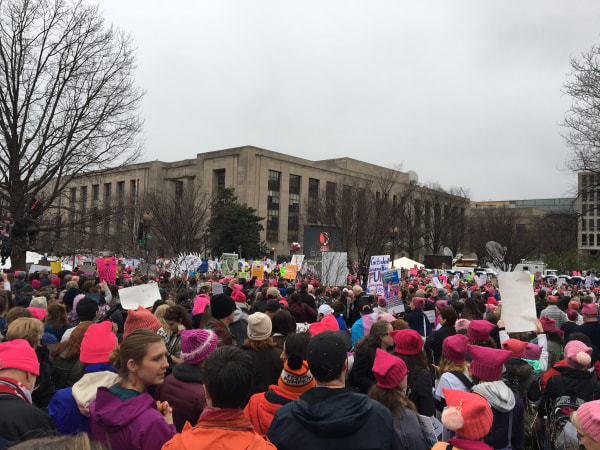
Latinas across the country who organized and went to the marches and events told NBC Latino why they rallied.
"It's important through this march that we understand the role women have played throughout history: To be part of this march, is to carry on their legacy; Berta Cáceres, the indigenous woman who fought for water and was murdered. All of our moms, grandmothers and sisters," said Angela Adrar, 41, the executive director of Climate Justice Alliance in Washington D.C.
"This march is a visual representation of our power," said Adrar, who is Colombian American. She crossed the border with her mother at the age of five.
https://twitter.com/LyanneAlfaro/status/822825771127422976
Latinas participated in massive marches across the country Saturday to usher in a new fight for civil and gender rights, environmental protections, access to reproductive health services and immigrant rights. The diversity of these women marching demonstrated that these issues cross personal boundaries and physical borders.
Women's marches and rallies were held in cities all over the United States - as well as around the world - and the crowds far surpassed the numbers that were expected. Over half a million people attended the largest march, in Washington D.C., originally the crowd was expected to be about 200,000.
Actress and activist America Ferrera kicked off the rally in the nation's capital. "It's been a heartwrenching time to be a woman and an activist in this country," said Ferrera. "The platform of hate and division assumed power yesterday," she said. "But the president is not America, his cabinet is not America, Congress is not America - we are America!"

Latinas across the country who organized and went to the marches and events told NBC Latino why they rallied.
"It's important through this march that we understand the role women have played throughout history: To be part of this march, is to carry on their legacy; Berta Cáceres, the indigenous woman who fought for water and was murdered. All of our moms, grandmothers and sisters," said Angela Adrar, 41, the executive director of Climate Justice Alliance in Washington D.C.
"This march is a visual representation of our power," said Adrar, who is Colombian American. She crossed the border with her mother at the age of five.
Jasmine Flanagan, 23, is at #womensmarch from California bc she wants kids she works with to know they have a voice
Melissa Montero Padilla, 35, of Puerto Rican and Ecuadorian descent, traveled from Queens, New York to attend the D.C. march. "I'm marching for my niece, our families, all of the single mothers, immigrant women and our elders; I march because our lives depend on it."
Cindy Wiesner, 45, came from Miami to Washington, D.C. to participate in the march.
https://twitter.com/SuzGamboa/status/822841438446690304
"As a daughter of a domestic worker, as a lesbian and as a feminist, I think that this march is really important, because the Trump and Pence administration, in a lot of ways, is going to target me, my community and the people that I love - who are very similar to me," said Wiesner, who is the executive director of Grassroot Global Justice Alliance.
"I think it is important to try and come out with thousands of other people - people who are coming out from all over the world," she said.
https://twitter.com/WomensMarchonWA/status/817572274056237056
Latinas participated in massive marches across the country Saturday to usher in a new fight for civil and gender rights, environmental protections, access to reproductive health services and immigrant rights. The diversity of these women marching demonstrated that these issues cross personal boundaries and physical borders.
Women's marches and rallies were held in cities all over the United States - as well as around the world - and the crowds far surpassed the numbers that were expected. Over half a million people attended the largest march, in Washington D.C., originally the crowd was expected to be about 200,000.
Actress and activist America Ferrera kicked off the rally in the nation's capital. "It's been a heartwrenching time to be a woman and an activist in this country," said Ferrera. "The platform of hate and division assumed power yesterday," she said. "But the president is not America, his cabinet is not America, Congress is not America - we are America!"

Latinas across the country who organized and went to the marches and events told NBC Latino why they rallied.
"It's important through this march that we understand the role women have played throughout history: To be part of this march, is to carry on their legacy; Berta Cáceres, the indigenous woman who fought for water and was murdered. All of our moms, grandmothers and sisters," said Angela Adrar, 41, the executive director of Climate Justice Alliance in Washington D.C.
"This march is a visual representation of our power," said Adrar, who is Colombian American. She crossed the border with her mother at the age of five.
Jasmine Flanagan, 23, is at #womensmarch from California bc she wants kids she works with to know they have a voice
Melissa Montero Padilla, 35, of Puerto Rican and Ecuadorian descent, traveled from Queens, New York to attend the D.C. march. "I'm marching for my niece, our families, all of the single mothers, immigrant women and our elders; I march because our lives depend on it."
Cindy Wiesner, 45, came from Miami to Washington, D.C. to participate in the march.
Lots of security but marchers thanking the soldiers on duty and taking selfies with Humvee.
"As a daughter of a domestic worker, as a lesbian and as a feminist, I think that this march is really important, because the Trump and Pence administration, in a lot of ways, is going to target me, my community and the people that I love - who are very similar to me," said Wiesner, who is the executive director of Grassroot Global Justice Alliance.
"I think it is important to try and come out with thousands of other people - people who are coming out from all over the world," she said.
Have you heard that @AmericaFerrera is set to chair an Artists’ Committee for the upcoming @womensmarch?!! #WMWhttp://www.huffingtonpost.com/entry/america-ferrera-to-chair-committee-for-womens-march-on-washington_us_586fb4dae4b099cdb0fcbe81 …
America Ferrera To Chair Committee For Women's March On Washington
She'll help Gloria Steinem, among others, organize the march.
huffingtonpost.com
Apart from América Ferrera, other big celebrities, such as Madonna, Alicia Keys, Amy Schumer, Scarlett Johansson, and Zendaya, were among the high-profile participants in the D.C. march.
Sonia Manzano, known to millions for her groundbreaking and decades-long role of "Maria" in "Sesame Street," traveled from NYC to D.C. to participate in Saturday's demonstration with a group of schoolgirls from New York City public schools.
"Hopefully they get involved and pay attention, and realize that they have a huge impact. If you don't participate, you matter even less," said Manzano. She told NBC Latino she hopes her participation will be example of the need to get involved.
https://twitter.com/SuzGamboa/status/822851872184737796
Latinas participated in massive marches across the country Saturday to usher in a new fight for civil and gender rights, environmental protections, access to reproductive health services and immigrant rights. The diversity of these women marching demonstrated that these issues cross personal boundaries and physical borders.
Women's marches and rallies were held in cities all over the United States - as well as around the world - and the crowds far surpassed the numbers that were expected. Over half a million people attended the largest march, in Washington D.C., originally the crowd was expected to be about 200,000.
Actress and activist America Ferrera kicked off the rally in the nation's capital. "It's been a heartwrenching time to be a woman and an activist in this country," said Ferrera. "The platform of hate and division assumed power yesterday," she said. "But the president is not America, his cabinet is not America, Congress is not America - we are America!"

Latinas across the country who organized and went to the marches and events told NBC Latino why they rallied.
"It's important through this march that we understand the role women have played throughout history: To be part of this march, is to carry on their legacy; Berta Cáceres, the indigenous woman who fought for water and was murdered. All of our moms, grandmothers and sisters," said Angela Adrar, 41, the executive director of Climate Justice Alliance in Washington D.C.
"This march is a visual representation of our power," said Adrar, who is Colombian American. She crossed the border with her mother at the age of five.
Jasmine Flanagan, 23, is at #womensmarch from California bc she wants kids she works with to know they have a voice
Melissa Montero Padilla, 35, of Puerto Rican and Ecuadorian descent, traveled from Queens, New York to attend the D.C. march. "I'm marching for my niece, our families, all of the single mothers, immigrant women and our elders; I march because our lives depend on it."
Cindy Wiesner, 45, came from Miami to Washington, D.C. to participate in the march.
Lots of security but marchers thanking the soldiers on duty and taking selfies with Humvee.
"As a daughter of a domestic worker, as a lesbian and as a feminist, I think that this march is really important, because the Trump and Pence administration, in a lot of ways, is going to target me, my community and the people that I love - who are very similar to me," said Wiesner, who is the executive director of Grassroot Global Justice Alliance.
"I think it is important to try and come out with thousands of other people - people who are coming out from all over the world," she said.
Have you heard that @AmericaFerrera is set to chair an Artists’ Committee for the upcoming @womensmarch?!! #WMWhttp://www.huffingtonpost.com/entry/america-ferrera-to-chair-committee-for-womens-march-on-washington_us_586fb4dae4b099cdb0fcbe81 …
America Ferrera To Chair Committee For Women's March On Washington
She'll help Gloria Steinem, among others, organize the march.
huffingtonpost.com
Apart from América Ferrera, other big celebrities, such as Madonna, Alicia Keys, Amy Schumer, Scarlett Johansson, and Zendaya, were among the high-profile participants in the D.C. march.
Sonia Manzano, known to millions for her groundbreaking and decades-long role of "Maria" in "Sesame Street," traveled from NYC to D.C. to participate in Saturday's demonstration with a group of schoolgirls from New York City public schools.
"Hopefully they get involved and pay attention, and realize that they have a huge impact. If you don't participate, you matter even less," said Manzano. She told NBC Latino she hopes her participation will be example of the need to get involved.
MT: Rina Gandhi, immig atty: calls from fearful immigs. spiked on Inauguration Day. W/ sister Mona and husband Juan Moreno @ Women's March
There was a reason this march resonated with so many, but especially women all over the country, says gender politics professor Celeste Montoya.
"Many people were disappointed and angry after the election," Montoya said. "Issues of gender were front and center with Hillary Clinton as the Democratic candidate and with Trump's polarizing sexual assault and discrimination; it caused people to mobilize."
Montoya believes we are in a social movement era and said she wasn't shocked to see how quickly the women's marches gained traction.
"This is what happens in democracy when people are left out, and I expect to see more," said Montoya, who teaches at the University of Colorado-Boulder. "This is just the beginning."
In New York City, singer and songwriter Cecilia Villar El Juri said that she got involved because she wanted to make sure that Latinos and immigrants were represented. "The march is meant to promote civil rights for everyone. I felt like I really aligned with that. This is open to everybody - but driven by women," Villar El Juri said.
Organizers and volunteers for the New York City Women's March vary in age, are multi-generational, and are made up of women from varied careers, explained Villar El Juri. She and other organizers had spent a lot of time preparing for the march, including in-person and online meetings and dry runs of the event. Organizers of the march also met with the the New York Police Department for permits and to make sure it was a peaceful effort.
https://twitter.com/LyanneAlfaro/status/822827652327342080
In San Francisco, Leila Salazar-Lopez was marching for many reasons, one of those being environmental issues. Salazar-Lopez is the executive director of Amazon Watch, and says that she and her colleagues have worked hard to protect the rain forest for over 20 years, but fears that the incoming administration might disregard that.
"We have an administration that denies climate change," Salazar Lopez says. "It's one of the biggest threats our society has ever faced. It's our job, not only to amplify the voices, but to also promote the protection of mother earth in a positive way."
Salazar-Lopez says that indigenous communities, black and brown, are the communities most affected by environmental issues. She says there's no way to have climate justice, unless companies and corporations stop extracting fossil fuels from the ground.
The march was the beginning of something that Salazar-Lopez said she believes needs to keep moving forward.
"If there's ever a moment for us to do something, it's now," said Salazar-Lopez. "We have to stand up for ourselves. Not just to protest, but to put out our visions of what we want in the world."
Washington streets reveal US political divisions on inauguration day
Trump supporter poses for selfie with cutout board of new president (Ali Harb/ MEE)
Some Americans reject Trump and question his legitimacy, others view him as man to make America great again
WASHINGTON, DC - Three llamas roaming the streets of Washington DC; a preacher yelling anti-Muslim and homophobic slogans; women chanting “pu**y grabs back”; folks exchanging insults; burning trash cans in the middle of the road - inauguration day 2017 has not been ordinary.
Since George Washington handed the White House keys to John Adams in 1797, America has prided itself on the peaceful transfer of power. But when Donald Trump was sworn in as president on Friday to replace Barack Obama, the nation seemed unsettled.
Some Americans reject the new president and question his legitimacy, while others view him as an embodiment of his campaign slogan - the man to make America great again.
https://www.facebook.com/MiddleEastEye/videos/1253163621415690/
This political and ideological schism was obvious on the streets of the US capital as supporters sang praises of Trump and protesters screamed “Not my president”.
The demonstrators view Trump as more than a president with opposing political views. They see him as an Islamophobic white nationalist who is also a sexual predator and unfit to serve.
But the president’s backers say others’ perception of him is a product of a hostile media. They say he is a successful businessman who puts America first, someone who can translate his personal achievements into prosperity for all Americans. They point to his outsider status to argue that he is not a corrupt politician.
"He is the first president of the US who has neither been in the military or the government beforehand and that gives me confidence he is a true outsider,” Tim Mouring, a student and Trump supporter, told Middle East Eye. “He is not part of any big system, he is truly independent and he wants us all to be independent."
In November 2015, Trump suggested to temporarily ban Muslims from entering the US, shortly after militants conducted an attack in Paris. The proposal caused an uproar among civil rights organisations and earned rebuke even from Trump’s fellow Republicans.
Islamophobia
Asked about the ban, Mouring said the president is not anti-Muslim, but is simply trying to protect Americans, including US Muslims, from radical militants.
In his inaugural speech, Trump vowed to eradicate “radical Islamic terrorism” from the face of the earth.
Ramah Kudaimi, an outreach coordinator for the nonprofit Washington Peace Center, thought Trump's speech was overtly Islamophobic.
“Muslims are demonised to the point of being seen as nothing but terrorists,” she told MEE. “The Muslims that are ‘accidentaly’ killed in this war against terrorists are just collateral damage and we shouldn’t be concerned with them.”
She added that former presidents Barack Obama and George W Bush had bombed Muslim majority nations but pretended they were not at war with Islam. She thinks that Trump's intentions are different from the start.
“Muslims are demonised to the point of being seen as nothing but terrorists” - Ramah Kudaimi
“It’s a very scary thought,” Kudaimi said.
Most Trump supporters dismissed accusations of Islamophobia, but a few openly shouted bigoted slogans towards Muslims.
Early in the morning as people were lining up to get to the National Mall to witness the inauguration, a preacher with a handful of followers stood between two queues hurling slurs against Muslims, gays and women on a megaphone.
“We support our president when he says deport those Muslims,” said the preacher, who leads a group called Bible Believers.
The Bible Believers were only booed by the pro-Trump crowd when they said a woman cannot serve as president.
Caroline Spitsel, 19, said the silence among Trump supporters towards anti-Muslim demonstrators means they are complicit in condoning his bigotry.
Asked about Trump’s problematic policy proposals, including the Muslim ban and mass deportation of undocumented immigrants, Spitsel told MEE: “I think he will have a hard time doing it, but it’s definitely a real threat.”
'It doesn’t look like them'
“The oath of office I take today is an oath of allegiance to all Americans,” Trump said as he officially became president.
But not all Americans were convinced.
While Trump was delivering his inaugural speech, protesters gathered near the Lincoln Memorial, chanting, “Pu**y grabs back”, in reference to leaked Trump video where he brags about being able to grab women’s genitals because he is a celebrity.
Protesters also repeated slogans in support of Muslims, African Americans and LGBT individuals. They hugged one another in a show of unity and solidarity.
“White silence is violence,” the demonstrators also chanted - a reference to Trump supporters who may not be bigoted themselves but are willing to overlook his supposed racism for other policies.
Protesters set up a blockage by placing and lighting trashcans on fire (MEE/Ali Harb)
A speaker at the gathering said the protesters “already won” by standing together against the new president from day one.
“If America is going to continue to be what America is, it looks just like this,” he said, in reference to the diverse protesters.
“It doesn’t look like them over there,” he continued, pointing at the inauguration attendees. “We all have something to learn from each other, and if we can’t understand that, then we’re not American anymore.”
As Trump supporters began leaving the National Mall area, some confronted protesters. Insults and name-calling were exchanged between supporters and demonstrators.
“Losers,” one man leaving the national mall told protesters. “You Lost. Go home.”
A Trump supporter called the demonstrators undemocratic. He told MEE that he had disagreed with Obama's policies but he never protested his two inaugurations out of respect for the election results.
After the inauguration, Trump supporters praised his seemingly reconciliatory approach.
One protester called Trump a “horrible, misogynistic, racist” president. She said he cannot be a president for all Americans because of his previous positions, including mocking a disabled New York Times reporter.
He is “accepting all kinds of support from and for Israel’s right-wing government,” the protester told MEE. “We can bring light to equality and social justice. At the end of the day it doesn’t matter, the people of money have the power. The rest of us are the 99 percent. We don’t matter unless we band together.”
The demonstrator, a Jewish American, said Jews have a moral obligation to speak out against Trump.
“Putting Muslims in a registry - that sounds too familiar. And it’s not OK,” she said, making reference to Nazi Germany.
The carnival
Washington looked like a massive political carnival. From non-ideological vendors selling pins and T-shirts to groups with fringe views to funny signs mocking Trump.
One man walked around with three llamas to make a pro-agriculture statement against corporate control.
One man walked around with three llamas to make a pro-agriculture statement (MEE)
Some Trump supporters were dressed in suits depicting the American flag.
Christian activists stood with big signs proclaiming apolitical religious messages.
Pro-cannabis activists passed thousands of marijuana joints and smoked them publicly.
Protesters held humorous signs poking fun at the new president’s alleged ties to Russia, comb-over hairdo and supposedly small hands.
Some clashes were reported between Trump supporters and protesters. More than 90 people were arrested for disorderly conduct. As the night darkened, fears of demonstrations transitioning into riots were heightened.
However, in spite of the chaos, some protesters saw hope.
Bayan Jaber, a Palestinian-American activist with Southwest Org Project, said Trump and his cabinet are a threat to Americans’ civil liberties, especially for women of colour.
However, she added: “We should stand in solidarity with our brothers and sisters, protect our land, protect our water, protect our lives. One positive thing that might come out of Trump’s presidency is that we will be seeing more solidarity around struggles across the nation.”
Black activists rally for domestic workers, immigrants — just outside the Women's March
Source: Mic
https://mic.com/articles/166255/black-activists-rally-for-domestic-workers-immigrants-just-outside-the-women-s-march#.ieZEmfWsO
Published Jan. 21, 2017
WASHINGTON — If there was one major concern of some black activists regarding Saturday's Women's March on Washington, it was that the voices of the most marginalized women of color didn't have prominent billing.
That's why a group of women and men representing domestic workers, undocumented immigrants and the working poor met less than a mile from the march's rallying point to elevate their voices. They supported the march, but wanted to affirm their cause, one day after the inauguration of Donald Trump, who they see as a direct threat.
"This is a march that should highlight our voices, the grassroots," Melissa Miles, an organizer of the social justice agency Ironbound Community Corporation in Newark, New Jersey, said at a rally in Garfield Park. "That's why we're over here."
In an interview with Mic, Alicia Garza, co-founder of the Black Lives Matter Global Network and an organizer with the National Domestic Workers Alliance, said it was important that activists not allow their voices to be drowned out in the sea of thousands gathered at the Women's March.
https://www.facebook.com/TheMovementByMic/videos/372368213121598/
"I know there's been a lot of critique about this march, with folks saying, 'Oh, it's a white women's march," Garza said in the interview. "But look at all these beautiful people. We're not here to prove our humanity. We're here to lift ourselves up, to lift each other up and chart a new path towards the democracy we deserve."
Lydia Scott, a 53-year-old babysitter and NDWA supporter from New York City, said many black immigrant women like her lack the provisions like time off and sick pay that many working women take for granted.
"Half the time, we don't get the chance to express ourselves," Scott, an immigrant from Grenada and mother of three adult children, said. "Financially, [domestic workers] can't leave their jobs to be here. Their bosses wouldn't tolerate this."

Source: Aaron Morrison/Mic
"I'm here sacrificing so that my own children won't feel ashamed," Scott said. When she told her children why she was attending the march, they responded, "Right on mother!"
Well-known facts about the status of women in the U.S., such as the pay disparity compared to men, often don't cover black female immigrant workers, Toni DaSilva, an NDWA supporter and immigrant from St. Vincent and the Grenadines, said in a interview. "Not to have data on them is an atrocity," she said. "Because you can't plan for them, they become a phantom group. They go through all sorts of issues that maybe can't be highlighted because of their status."
The assembled women had a significant amount of support from men. Timothy Doe, an immigrant from Togo who works as a caregiver for the developmentally disabled, said his rights are inextricably linked to the status of women of color who do the majority of domestic work.
"Men have to be a bigger support for the women, because the woman is the power of our life," Doe said. "They are our mom, our sisters, our daughters, our wife, our girlfriend. So, the men must stand up and support the women."
The delegation in Garfield Park rallied for an hour and made a procession to the march, where speakers highlighted issues important to the women of color. Newly elected African-American U.S. Senator Kamala Harris fired up marchers with a speech about equality for women.
https://twitter.com/KamalaHarris/status/822872322596081666
"Show some respect," Jibby Ani, a black Washington resident, recalled saying to people around her who were jeering. "I just felt a little marginalized, in that moment."
Jan. 22, 2017, 7:49 a.m.: This story has been updated.
Disruption Is Good—Starting with the Inauguration
Progressive groups across the spectrum faced an influx of calls and interest almost immediately post-election, and—for many—this weekend’s protests will feed into longer-term organizing. (Photo by Mario Tama/Getty Images)
http://inthesetimes.com/article/19830/disruption-is-goodstarting-with-the-inauguration
This weekend’s protests are just the beginning.
BY KATE ARONOFF, In These Times
There’s another kind of inauguration happening in Washington D.C. today. There’s no ticket needed to get in or balls commemorating it. As Donald Trump gets sworn in as the United States’ 45th president, those opposed to his agenda—especially those most likely to come under attack—are kicking off his tenure with resistance.
Early this morning, at a series of checkpoints and intersections around the inauguration stage, groups representing everything from the movement for black lives to a feminist future and climate justice are attempting to block people from reaching the inauguration stage or—at the very least—show their distaste for what’s happening. On Saturday, the Women’s March will bring hundreds of thousands of people to the Capitol and thousands more out to satellite demonstrations around the city.
“If people don’t organize and mobilize together, they are vulnerable. And we’ll see the unravelling of what this country was built on: the notion that there are freedoms and liberties that people have risked their lives for to come to this country,” says Día Bùi, co-director of the Washington Peace Center and organizer of one of today’s actions. Leading up to Friday’s protests, she and others gathered for trainings and teach-ins at churches and community spaces around the city.
Bùi helped plan a blockade this morning of “communities under attack,” comprised largely of immigrants, Muslims and Jews. Disrupt J20 more generally, she tells In These Times, was initiated by longtime organizers in Washington, D.C., eager not to have the concerns of the people who live in the city—particularly low-income communities and communities of color—left out of the story told about who’s resisting Trump, especially in his own backyard.
About 140 people marched toward a checkpoint, shouting out chants like, “Say it loud, say it clear. Refugees are welcome here!” Members of Showing up for Racial Justice (SURJ) were tasked with interfacing with Trump supporters, though relatively few passed by.
Asked why she’s come to Washington, Melissa Miles, of Newark, New Jersey’s Ironbound Community Corporation, says, “To visibilize us. They want to bury, but we’re seeds. We’re going to sprout and grow. The shit they’re throwing at us is going to be the fertilizer.”
She’ll participate in the Women’s March as part of the It Takes Roots contingent, one of many heading to the march being headed up by grassroots organizers from African-American, Latino, Asian, Pacific Islander, indigenous and poor white communities around the country. “More than ever, this is a moment to come out of our comfort zone, leave our fears behind and really stand up,” Miles told In These Times.
It’s not just that people are resisting Trump, she says, but how. Progressive groups across the spectrum faced an influx of calls and interest almost immediately post-election, and—for many—this weekend’s protests will feed into longer-term organizing. Both Miles and Bùi hope to capitalize on the momentum generated by Trump’s election and see this weekend’s demonstrations as part of a much larger effort.
Because of the fusion of misogyny and racism that Trump’s Cabinet represents, Miles argues, taking leadership from the people and communities most likely to come under increased threat because of the Trump administration is a move that's as strategic as it is solidaristic.
The narrative that protests are the domain of well-off, sign-sporting college students is a convenient one for Trump. But the history of protest in the United States—from the labor militancy of the 1930s to the civil rights movement to ACT UP—is one that’s been led most fiercely by the people bearing the brunt of regressive policies. Ignoring that risks muting the fact that there is real resistance to Trump, a president who didn’t win the majority of the popular vote and doesn’t have the majority of the country’s support.
Complimenting history’s big and successful demonstrations, too, has always been the less glamorous work of organizing that’s won major egalitarian and redistributive reforms. The same has been true of the right, which lifted its own traditions of organizing from the left. The “handbook” of the Tea Party, famously, was Saul Alinsky’s Rules for Radicals: A Pragmatic Primer for Realistic Radicals, inspired partially by communist organizers in the Congress of Industrial Organizations (CIO).
“The protest is a mechanism for us to bring people together,” Bùi says, “and send the message to an administration, which has already shown that it’s not interested in hearing directly from the people.”
Whether he wants to or not, Trump will hear from them today.
10 Housing Policies to Watch Under President Trump
Incoming housing secretary Ben Carson gave hints of his policy positions as candidate, but did little to flesh them out at his confirmation hearing.
http://citylimits.org/2017/01/19/10-housing-policies-to-watch-under-president-trump/
By Abigail Savitch-Lew |
From NYCHA’s $17 billion repair backlog to the deficit of rental assistance in a city with soaring housing costs, New Yorkers have long suffered from the federal government’s reduced spending on housing, which remains far below pre-Reagan era levels. In the country as a whole, the unmet needs are momentous, with only one fourth of eligible low-income households receiving the rental assistance they need to afford a home.
And just as we would seem to need it most—with discussions in rezoning neighborhoods often revolving around the question of how much subsidy is available to help low-income households remain in their neighborhoods—many housing and tenant advocates fear that things are about to get a whole lot worse. The president-elect is a real-estate developer with a track record in New York City of discriminating against black tenants and trying to flout affordable housing laws; he has nominated a former Wall Street bank chair for Treasury secretary, and appointed a private equity CEO as a top adviser.
“It’s incredibly concerning to have a developer like Donald Trump that’s going to be in the White House,” says Katie Goldstein, executive director of the statewide organization Tenants and Neighbors. “He was really elected on the idea of going on the aggressive toward poor people, low-income [people] and communities of color.”
Some housing advocates are hoping there may be opportunities to influence the incoming administration in their favor. The National Low Income Housing Coalition (NLIHC), which includes New York groups like Tenants and Neighbors and Supportive Housing Network of New York, sent a letter to the president-elect urging him to invest in housing as part of his plan to rebuild America’s infrastructure. Some have also expressed hope that Ben Carson, Trump’s nominee for the Department of Housing and Urban Development (HUD), might be open to persuasion given his lack of clear policy stances—and seeming desire to please everyone—at last week’s hearing. James Saucedo, a NLIHC organizer, says the coalition will focus its energy on making the case to Republicans that housing affordability and poverty are crucial issues for every district in the country.
“It would be short-sighted and it would be a failure for the people that we care about to not be willing to work with them,” he says.
Others say they expect only complete austerity from the feds, but hope the threat of Trump will galvanize local governments to more seriously address housing issues using their own budgets. In the online journal Metropolitiques, CUNY professor John Krinsky says that for Cuomo and de Blasio to live up to their progressive credentials, they must “[address] themselves seriously to what will happen once the federal government stops supporting public housing and cuts back on vouchers.” To Krinsky, that means ending the 421-a tax break, which the city says promotes rental housing construction but which Krinsky argues could be used to fund more than 100,000 Section 8 rental vouchers. It would also mean using city dollars more effectively, which he says could be done by “breaking with 20-year-old preferences for reliance on private, for-profit developers who have little interest in developing affordable housing for very poor people” and instead working with non-profit developers.
The Right to the City Alliance (RTTC), a national coalition with 10 New York City member organizations including Picture the Homeless, GOLES and FUREE, has a few national demands, but will continue to employ a “trans-local” strategy with the hopes that the threat of Trump will push local policymakers to work more closely with grassroots activists, particularly to implement RTTC’s demands for universal rent control and community control of land through the creation of community land trusts. RTTC organizer Tony Romano is hopeful: Tenant movements are experiencing an upsurge, with several California cities starting or strengthening rent control this November for the first time in decades. Furthermore, the threat of Trump is helping to break silos between different social justice movements, he says. This weekend, Right to the City will be participating in direct actions across the country in alliance with other grassroots groups. Organized under the banner “It Takes Roots to Grow the Resistance,” Romano says the new alliance is united in a push for low-income communities of color to control their own fates.
But even if we can hope for progress on a local level, New Yorkers can’t afford to ignore housing problems outside city borders, says Laura Mascuch, director of the Supportive Housing Network of New York. Rural counties—including areas of upstate New York—depend on federal sources for a greater portion of their housing budgets, and their housing problems affect city residents, too: Nationally, homeownership rates are at their lowest in fifty years, which experts say is helping to drive up demand in the rental market, worsening the affordability crisis in cities. One election result analysis shows a correlation between negative home values and support for Trump. In other words, hiding in a progressive bubble while ignoring federal fights is probably not the answer, either.
Here are 10 national housing battles in the hands of Congress and the White House that activists say could be worth following in the months to come.
1. Protecting HUD from the Ax: In recent years, HUD has been repeatedly subject to spending caps. Low-income housing advocates want those caps lifted and HUD’s budget increased to keep apace with rising fair market rents, but the Trump administration has called for an even greater cut to non-defense spending—a cumulative cut of one percent each year, or what would amount to a 30 percent cut to HUD’s budget by 2026, accounting for inflation. Advocates say such cuts would be detrimental to New York’s public-housing capital backlog, the availability of Section 8 vouchers and the provision of project Section 8 contracts. While Carson recognized at his confirmation hearing that rental assistance can be “life saving,” he also said he supports Trump’s annual one percent cut to non-defense spending, and wants to do more research before proposing a HUD budget. “I don’t know what the number is going to be, quite frankly. It might more, it might be less,” he said.
2. Defending Obama’s Progress on Fair Housing: To improve the implementation of the Fair Housing Act of 1968, which requires that governments work toward reducing barriers to housing and equal opportunity, the Obama administration developed a new rule, along with a set of implementation tools, that would help local governments assess the impacts of their policy decisions on combating housing segregation and discrimination. Republican lawmakers have argued Obama’s efforts are tantamount to social engineering and have introduced bills to outlaw the new program. Carson once called Obama’s fair housing program a “failed socialist experiment,” but at his confirmation hearing emphasized that he was only against “cookie-cutter” government programs, though how this statement applies to Obama’s program is unclear.
3. Growing the National Housing Trust Fund: Created in 2008, this fund finally got its first round of funding after years of delay last year and provides states with block grants to build, preserve, and rehabilitate rental housing, with 75 percent dedicated to extremely low-income families making less than 30 percent of the Area Median Income. It derives its funding from an assessment on Freddie Mac and Fannie Mae’s earnings. Low-income housing advocates would like to see the assessment rate increased or a permanent budget allocation to the fund, but Republicans have called investments in the fund a “lump of coal in the stocking of every American taxpayer.”
4. Opposing Work Requirements and Time Limits: In a policy brief released last June, House Republicans said HUD’s rental assistance programs “lack requirements to encourage greater individual self-sufficiency,” and called for work-requirements for work-capable households receiving rental assistance, as well as time-limits to benefits. Carson remained vague at his hearing about these policies, saying he saw the necessity of housing assistance to helping families move out of poverty, but also wanted to place “a little more time and effort developing the potential of our people.” Low-income housing advocates argue that such policy ideas are rooted in poor-shaming, disregard the fact that many people on rental assistance do work or are family caretakers, and argue that attaching such requirements to welfare in the 1990s did not eliminate, and in some cases worsened poverty.
5. Ending Subsidies for Rich Homeowners: Of the $200 billion* the federal government spends each year on housing aid, eight out of ten dollars goes to families earning more than $100,000 and four out of ten to families making more than $200,000. The biggest culprit for this regressive redistribution is the mortgage deduction tax program, which provides large tax breaks to wealthy homeowners. Housing advocates in the United for Homes Campaign seek revisions of the program that they say would shift the benefits of the tax credit to low-income homeowners while creating $241 billion in savings over the next ten years. There are signs that Republican lawmakers may be open to considering these reforms, but whether they will be willing to reinvest the savings in low-income housing programs is another question.
6. Reforming and Bolstering the Low Income Housing Tax Credit (LIHTC) program: This program, currently the federal government’s primary funding source for new affordable housing projects, allows local governments to sell tax credits to investors, generating funding for construction. Some low-income housing advocates like NLIHC and the affordable housing industry want to see an expansion of, and reforms to, the LIHTC program. Republicans have been friendly to LIHTC, and have worked with Democrats to introduce legislation that would expand the program. But Trump has also endorsed a House proposal to reduce the corporate tax rate from 30 percent to 15 percent, which could make investors less interested in buying tax credits and undermine the effectiveness of LIHTC.
7. Protecting Homeownership Opportunities: Freddie Mac and Fannie Mae are government-backed, for-profit private enterprises that buy mortgages and sell them to investors, which helps ensure a stable and ongoing supply of mortgage money for homeowners. During the mortgage crisis of 2008, the two giant enterprises nearly collapsed and were taken over by the federal government. Republicans, including several of Trump’s cabinet picks, argue that the government’s role in these enterprises places taxpayers at risk, and say that they should again be privatized to give other lenders the opportunity to compete with them. But a Wall Street Journal analysis suggests privatization would benefit Freddie and Fannie’s shareholders more than it would taxpayers, and some low-income housing advocates want to ensure privatization does not have negative impacts on homeowners and on the revenues of the housing trust fund. Carson has once again given mixed message on this front, saying he wants to lessen “government footprint” but also protect homeownership opportunities.
8. Saving At-Risk Homeowners from Private Equity: Following the 2008 mortgage crisis, HUD’s Federal Housing Administration, Freddie Mac and Fanny Mae began selling bundles of at-risk mortgages to hedge funds and private equity companies in an effort to bolster their hard-hit finances. But Right to the City and other advocates say that private buyers drive homeowners into foreclosure, then flip the properties to make a profit. (Private equity representatives dispute these claims, and HUD has made changes to the program in response to concerns.) Right to the City contends that these agencies should instead retain these homes as public assets or transfer them to community land trusts.
9. Bolstering Obama’s Local Hire Work: The Obama administration is in the process of revising the Section 3 rule, which requires local governments that take advantage of HUD funding to ensure 30 percent of workers are residents of HUD housing programs. It will be up to Carson to see through revisions to the rule, which would expand the requirements to more projects.
10. Ending Housing Discrimination Against Those with Convictions: HUD rules restrict people with criminal convictions from living in or even visiting public housing. Yet movements have been underway in many cities, including New York, to remove some of these restrictions. The Obama administration also released a draft rule last spring that forbids private property owners from throwing out a rental housing application simply on the basis of an applicant’s prior conviction. While criminal justice advocates hope to continue eliminating restrictive polices, Republican Speaker Paul Ryan has in the past opposed reform efforts.
Correction: Originally we said the federal government spends $200 million on housing aid. The actual amount is $200 billion.
City Limits coverage of housing policy is supported by the New York Community Trust and the Charles H. Revson Foundation.
Rising Up and Shutting it Down: The Trump Inauguration Protests in Images and Quotes
http://www.alternet.org/rising-and-shutting-it-down-trump-inauguration-protests-images-and-quotes
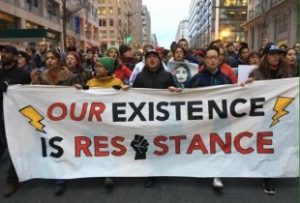
Early Friday morning, social movements from across the country converged in numerous locations across Washington, D.C., including 14 different "security" checkpoints, to shut down, slow and disrupt the presidential inauguration of Donald Trump. From Standing Rock Indigenous water protectors to Movement for Black Lives organizers, activists locked down and staged blockades to delegitimize a ceremony for a figure who rose to power on a tide of white nationalism and neo-fascism.
The large numbers took action in step with people across the United States and world.
“We must take to the streets and protest, blockade, disrupt, intervene, sit in, walk out, rise up, and make more noise and good trouble than the establishment can bear,” declared the Washington, D.C.-based Disrupt J20 Collective in a call-to-action released ahead of Thursday. “The parade must be stopped. We must delegitimize Trump and all he represents. It’s time to defend ourselves, our loved ones, and the world that sustains us as if our lives depend on it—because they do.”

(Photo Credit: It Takes Roots to Grow the Resistance / Grassroots Global Justice Alliance)
AlterNet asked activists why they decided to put their bodies on the line. "My message is, don't be afraid," said Kandi Mossett, an organizer with the Indigenous Environmental Network who traveled from Standing Rock to Washington, D.C. to protest Donald Trump's inauguration. "Any time we make our voices heard, we're not guaranteed to win our fight, but we know, beyond a shadow of a doubt, if we don't try we are guaranteed to fail. We are not afraid. We can all stand together and have unity.”
“On this inauguration day, we are making sure that we are visible and are being heard, as we understand the impacts of climate change on the frontlines,” continued Mossett, who is participating in the It Takes Roots delegation of the Grassroots Global Justice Alliance. “It is hard to describe being in a frontline community—the social impacts, the destruction that comes with the fossil fuel industry, all the violence. The abuses that go hand-in-hand with mother earth. We experience them firsthand. The Donald Trumps of the world don’t ever have to experience the pain and violence of the fossil fuels industry.”
“They need to hear from grassroots people,” Mossett told AlterNet. “If we have to travel all the way here to meet them where they are more comfortable, we will do that.”

Department of Energy disruption with Indigenous women leaders, veterans, climate and housing activists coming together. (Photo Credit: It Takes Roots to Grow the Resistance / Grassroots Global Justice Alliance)
"I am in tears. I am so honored to have co-organized the ‘Communities Under Attack Fight Back’ block to uplift Muslim resistance, immigrant resistance, Jewish resistance," said Darakshan Raja, founder of the Muslim American Women’s Policy Forum and co-director of the Washington Peace Center.
“For now, a day that I was afraid of is giving me more power than ever,” said Raja.

Groups centering immigrant, Muslim and Jewish resistance came together under the banner of ‘Communities Under Attack Fight Back’ to blockade a checkpoint to the inauguration in the early morning. (Photo credit: Mijente)
“The threats of mass deportation, the dismantling of Obamacare, the registration of Muslims and the criminalization of women’s health, are loud and clear,” said Black Lives Matter DC, Baltimore BLOC, and the Movement for Black Lives in a statement. “Black people and other people of color are being targeted by vigilantes, our places of worship are being burned, our children are being attacked at school and the promise of more 'law and order' policing leaves us even more vulnerable to police terror.”

Black Lives Matter DC, Baltimore BLOC, and the Movement for Black Lives shut down a checkpoint. (Photo credit: Disrupt J20)
https://twitter.com/DCMediaGroup/status/822468747831242752
“Trump stands for tyranny, greed, and misogyny,” said the Disrupt J20 Collective. “He is the champion of neo-nazis and white Nationalists, of the police who kill the Black, Brown and poor on a daily basis, of racist border agents and sadistic prison guards, of the FBI and NSA who tap your phone and read your email.”
"If there is going to be a positive change in this society," the collective continued, "we have to make it ourselves, together, through direct action."

(Photo credit: Disrupt J20)
Protests will continue to sweep Washington, DC and the United States throughout the weekend. Melissa Miles from It Takes Roots told AlterNet that she will be among those preparing to continue to mobilize in the days and years ahead. “I’m a grassroots feminist because I see the innate dignity in all life,” she said. “Because those who have suffered the most deserve the most to live happy healthy lives, because as long as I live I will fight for justice for those who have been denied it.”
Thuy Nguyen, a member of Iraq Veteran Against the War, told AlterNet that she took part in the disruptions "to stand in solidarity with my fellow brothers and sisters in the growing resistance, to get the conversation started that change needs to happen."
Sarah Lazare is a staff writer for AlterNet. A former staff writer for Common Dreams, she coedited the book About Face: Military Resisters Turn Against War. Follow her on Twitter at @sarahlazare.
Women of Color protect the land, water, and housing for all of us.
FOR IMMEDIATE RELEASE
January 19, 2017
Hundreds of Indigenous leaders, veterans, climate and housing activists from across the country join together to stage disruption at Department of Energy and HUD
WHEN: Friday, January 20
9am at the Department of Energy;
10am at the Department of Housing and Urban Development
WHERE: Beginning at 1000 Independence Ave. SW, Washington, D.C. (Department of Energy)
WHO: Hundreds of Indigenous peoples, leaders of climate justice movements, veterans, women of color and allies gathering to defend the land, water, bodies, and homes from tremendous threats posed by the incoming administration.
WHY: The appointments of Rick Perry, Steve Mnuchin, and Ben Carson make clear the Trump administration’s intention to ramp up the exploitation of land for private profit, wreaking devastation for the climate, for our water, and for our homes.
- Until a week ago, Rick Perry was on the Board of the company driving the Dakota Access Pipeline, which threatened the water of 17 million people.
- Trump has signaled his desire to re-enter an arms race, leading to a greatly intensified risk of nuclear war and to increased health threats in indigenous communities and communities of color where nuclear testing occurs.
- Mnuchin, Carson, and Trump together will threaten the homes of both homeowners and renters. Mnuchin is known as the “foreclosure king” for the over 36,000 foreclosures he instigated during the financial crisis. With half of all renters facing unaffordable rents and evictions at all-time highs, Carson has stated that he plans to turn public housing over to private interests, which will only worsen the displacement and affordable housing crises faced by communities around the country.
VISUALS: 75-foot banners, Indigenous women from Standing Rock, veterans, street theater to showcase threats posed by the Trump administration and what an alternative could look like – protecting the climate, land, and water for all people.
CONTACT: Isobel White, 510-828-3554
Bernice Shaw, 310-880-1389
###
It Takes Roots to Grow the Resistance
www.growtheresistance.org
5 Things you can do to Stand with Standing Rock
State violence is escalating against the Indigenous Water Protectors on the frontlines of the struggle against the Dakota Access Pipeline. Join us in responding to the call for national and international solidarity:
- GO TO STANDING ROCK and stand with the water defenders on the frontlines. Make sure you have: Your own transportation to camp, shelter/lodging, food, at least bring food for kitchen, warm clothing, positive prayerful mindset. The ask is for folks who are able to hold space, risk arrest, and follow local/ Indigenous leadership.
- DONATE to indigenousrising.org or ocetisakowincamp.org to support the legal team and the ongoing infrastructure needs.
- DISRUPT BUSINESS AS USUAL at the Army Core of Engineers Offices in your local community and demand that they deny the permit to bore under the Missouri River. Demand a full Environmental Impact Statement be completed.
- ORGANIZE LOCAL ACTIONS targeting the funders of DAPL, including the banks
- CALL THE WHITE HOUSE and urge President Obama to step in and reject the DAPL (202) 456-1111 or (202) 456-1414
The Indigenous-led struggle in Standing Rock, North Dakota against the Dakota Access Pipeline is a turning point in the climate justice movement. The proposed $3.8 billion Dakota Access Pipeline, if completed, would carry a half a million barrels of oil per day from the Bakken Oil Shale Fields. The route the pipeline would take lays under multiple bodies of water, including the Missouri River that supplies drinking and irrigation water that more than 10 million people depend on.
What began with Oceti Sakowin youth running 2000 miles from North Dakota to Washington DC in April of 2016 has now grown into a powerful grassroots movement that is forcing an injunction against one of the largest pipeline projects in North America.
Through leadership from the Indigenous Environmental Network (IEN), GGJ is collaborating with the Climate Justice Alliance to hold weekly Standing Rock solidarity calls for our members and allies. We are supporting delegations of frontline leaders heading to Standing Rock on an on-going basis.
We call on world leaders and global movement allies to Stand with Standing Rock and urge the US to immediately halt the Dakota Access Pipeline.
“It's important that the world understands the Standing Rock fight is about much more than stopping just one oil pipeline; it’s about all of us standing together from the North to the South and around the world to keep fossil fuels in the ground and create a just transition to a renewable energy economy." - Kandi Mossett of the Indigenous Environmental Network
#StandWithStandingRock #NoDAPL #WaterIsLife
